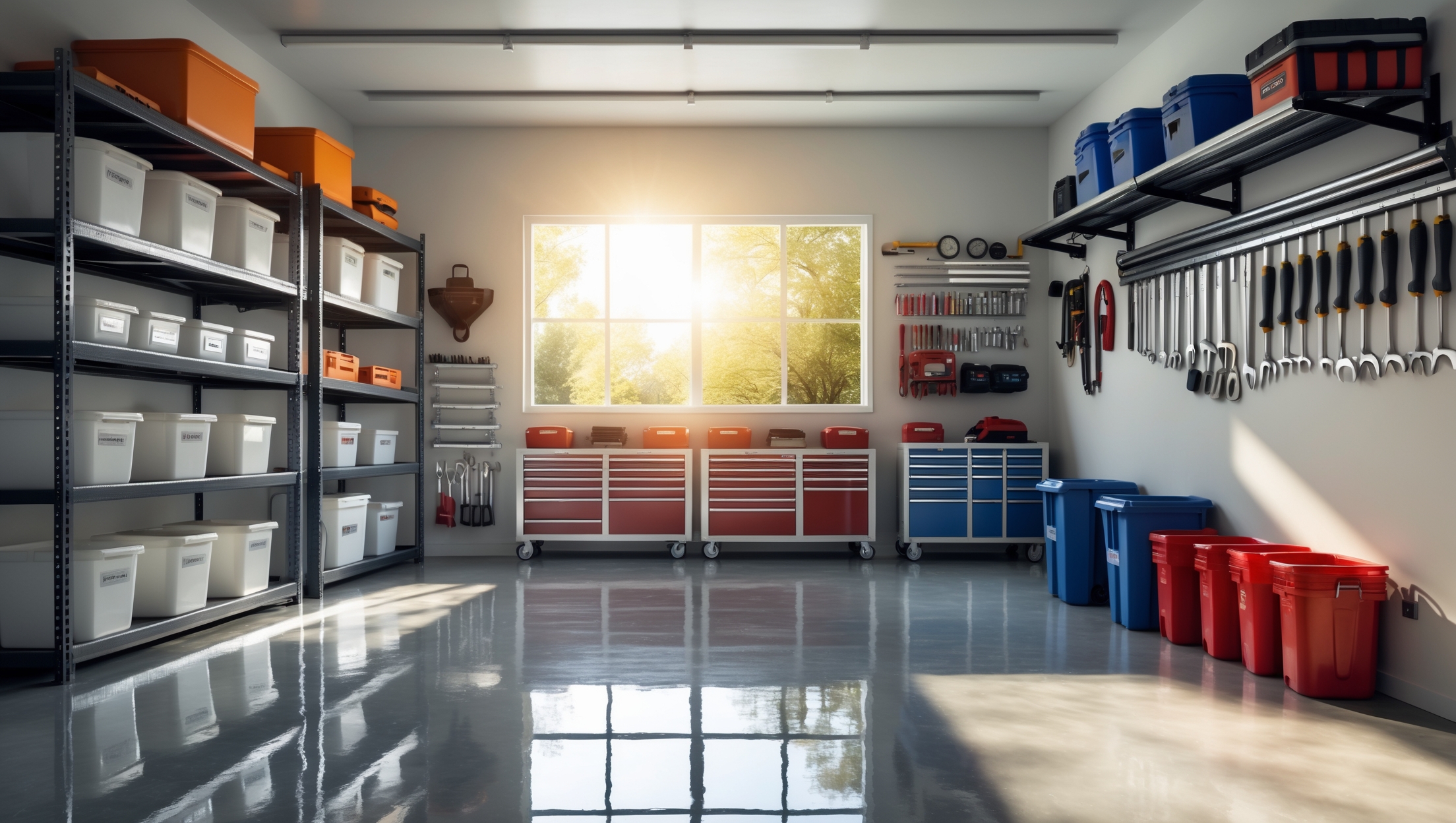Introduction: Why Garage Organization Matters More Than You Think
For many homeowners, the garage is a multi-purpose space—part storage room, part workshop, part parking spot. However, it’s all too easy for garages to become cluttered dumping grounds where tools, sports gear, holiday decorations, and forgotten projects pile up in chaotic heaps. The result? Lost items, wasted time, and, in some cases, safety hazards. An organized garage not only makes your daily routine smoother but also protects your belongings, maximizes usable space, and even adds value to your home. In this comprehensive guide, you’ll discover a proven, step-by-step process for overhauling your garage organization, practical storage solutions tailored to real-world needs, and essential maintenance tips to keep things tidy long after your initial effort. Whether you’re battling years of accumulated clutter or simply seeking a smarter way to store your stuff, these expert strategies will help you reclaim your garage and transform it into a functional, efficient extension of your home.
Step 1: Assessing Your Garage’s Potential
Understanding Your Goals and Limitations
Before you start clearing out boxes or buying new shelving, it’s crucial to define your objectives. Consider how you want to use your garage: Is it primarily for parking cars, a workshop, a storage area, or a combination? Assess the size, shape, and any existing obstacles such as water heaters, electrical panels, or immovable shelving. Take precise measurements of your garage’s dimensions, including ceiling height and the location of doors and windows. This information is essential for planning storage solutions and ensuring you don’t accidentally block access to important utilities.
Identifying Problem Areas
Take a walk through your garage and note where clutter accumulates, what items are difficult to access, and which areas are underutilized. Snap a few photos for reference. Common problem spots include corners packed with boxes, overflowing shelves, and floors crowded with loose items. Recognizing these trouble zones will help you prioritize your efforts and address the root causes of disorganization.
Step 2: Decluttering—The Foundation of Organization
Sorting: The Four-Box Method
Set aside a full day or weekend for decluttering. Gather four large containers or designate clear areas on your driveway labeled: Keep, Donate/Sell, Trash, and Relocate. As you handle each item, ask yourself when you last used it, whether it’s in working condition, and if it truly belongs in the garage. Be ruthless—sentimental attachment to broken garden tools or deflated basketballs only leads to more mess.
- Keep: Only items you use regularly and that are in good repair.
- Donate/Sell: Gear in decent condition but no longer needed.
- Trash: Broken, expired, or unusable items.
- Relocate: Belongings that belong elsewhere in the house.
Handling Hazardous and Bulky Waste
Paints, solvents, old batteries, and automotive fluids require special disposal. Check your city’s hazardous waste guidelines and schedule a drop-off if necessary. For large items like broken appliances, contact local recycling centers or municipal pick-up services. Clearing out these materials not only frees up space but also improves safety.
Step 3: Deep Cleaning—Setting the Stage
Once the garage is empty or mostly cleared, seize the opportunity to deep clean. Sweep and vacuum every surface, including rafters and corners where dust and cobwebs collect. Mop the floors or use a pressure washer if you have concrete. Wipe down shelves, windows, and light fixtures. Check for signs of pests and seal any gaps. This step not only makes your garage more pleasant but also helps prevent future problems like mold or insect infestations.
Step 4: Designing a Custom Storage Plan
Zones: Grouping by Function
Divide your garage into zones based on activity or item type. Typical zones include:
- Automotive: Car care products, tools, and spare parts.
- Sports & Recreation: Bikes, balls, camping gear.
- Gardening & Lawn: Tools, fertilizers, hoses.
- Workshop: Power tools, hardware, workbench.
- Household Overflow: Seasonal decorations, bulk pantry items.
Storing items by zone makes them easier to find and return after use, and helps prevent new clutter from forming.
Utilizing Vertical and Overhead Space
Most garages have underused vertical and ceiling space. Maximize storage by installing wall-mounted shelves, pegboards, or slatwall panels for tools and small items. Overhead racks can hold bins of holiday decorations, camping gear, or rarely accessed items. Ensure overhead storage is securely anchored to ceiling joists and keep heavy items lower down for safety.
Choosing the Right Storage Systems
- Shelving Units: Adjustable steel or heavy-duty plastic shelves are versatile and durable. Ensure shelves are rated for the weight of your items.
- Cabinets: Lockable cabinets are ideal for chemicals or sharp tools, especially if you have children.
- Pegboards & Slatwalls: Perfect for organizing hand tools, extension cords, and small parts. Accessorize with hooks, baskets, and bins.
- Bins & Totes: Clear, labeled plastic bins keep items dust-free and visible. Use stackable sizes to fit your shelves.
- Workbenches: If you use the garage as a workshop, invest in a sturdy bench with integrated storage drawers.
Custom or DIY Solutions
Consider custom shelving, built-in cabinets, or modular rack systems if your garage has unique dimensions or needs. DIYers can build simple lumber shelves or bike racks with minimal tools. Just be sure to anchor any large storage units to wall studs for safety and stability.
Step 5: Implementing Your Organization Plan
Installation Tips and Tricks
- Start with the largest items (shelving, cabinets, workbenches) first, placing them along unused walls.
- Install wall panels or pegboards above workbenches and in tool zones for easy access.
- Mount hooks or racks for bikes, ladders, and garden tools to free up floor space.
- Label every bin, tote, and shelf for quick identification.
- Use painter’s tape to mark parking spots or ‘no storage’ zones to keep walkways clear.
Safety Considerations
Avoid stacking heavy items on high shelves. Store flammable chemicals in lockable, ventilated cabinets away from heat sources. Maintain clear access to electrical panels, water heaters, and doors. For families, place sharp tools and toxic substances out of reach of children and pets.
Step 6: Smart Storage Solutions for Real-World Needs
Bike and Sports Gear
Wall-mounted bike racks or ceiling-mounted pulley systems keep bikes off the floor and easy to access. Use mesh baskets or ball claws for sports balls, and install hooks for bats, sticks, and helmets. Clear bins are perfect for smaller gear like gloves or pads.
Seasonal and Bulk Storage
Overhead racks or high shelves hold bins of holiday decorations, camping gear, and other seasonal items. Label each bin by season or holiday for quick retrieval. Use moisture-resistant totes for items susceptible to dampness or pests.
Tool Organization
Pegboards are the gold standard for hand tools, allowing you to customize layouts and make each tool visible. Magnetic strips hold wrenches and screwdrivers, while drawer organizers keep small hardware sorted. If you have power tools, consider a dedicated charging station with cord management solutions for battery packs and chargers.
Gardening and Lawn Equipment
Long-handled tools such as rakes and shovels fit neatly into wall-mounted racks or standing tool towers. Small items like seed packets, gloves, and pruners can be stored in labeled bins or drawer units. Install a hose reel near the garage door for quick watering access.
Step 7: Maintenance—Keeping Clutter at Bay
Establishing Habits and Routines
The hardest part of garage organization is maintaining it. Set aside 15 minutes each month to tidy up, return stray items to their zones, and sweep the floor. Do a quarterly review to purge items you no longer need, especially after holidays, sports seasons, or major projects.
Seasonal Maintenance Checklist
- Spring: Check for water damage or leaks, clean windows, and rotate seasonal gear.
- Summer: Sweep out dust, inspect for pests, and check overhead storage for sagging.
- Fall: Store summer equipment, prepare winter gear, and check insulation for energy efficiency.
- Winter: Keep walkways clear, inspect for salt or ice damage, and rotate stored items as necessary.
Quick Fixes for Common Setbacks
- Lost items? Revisit your labeling system and adjust zones as needed.
- Overflowing bins? Make it a rule to donate or discard one item for every new item you store.
- Family members ignore the system? Post a simple map or checklist on the wall as a reminder.
Step 8: Real-Life Case Study—A Garage Makeover in Action
Meet the Thompsons, a family of four whose garage had become a catch-all for everything from muddy soccer cleats to old paint cans. After a weekend of decluttering, they invested in sturdy steel shelving, a pegboard tool wall, and ceiling-mounted racks for seldom-used camping gear. By dividing the space into clear zones—sports, tools, gardening, and household overflow—they reduced time spent searching for items by half. Seasonal maintenance routines and a rule of ‘in and out’ for new belongings have kept their garage organized for over a year, proving that a strategic setup and simple habits can deliver lasting results.
Conclusion: Reclaiming Your Garage, Reclaiming Your Space
Transforming your garage from a cluttered catch-all to a streamlined, functional space is more than a one-time project—it’s an investment in your home’s value, your family’s safety, and your everyday efficiency. The process may seem daunting at first, but breaking it down into clear, manageable steps makes it achievable for any homeowner. By starting with a thorough assessment and ruthless decluttering, deep cleaning, and then implementing a custom storage plan, you set the foundation for lasting organization. Smart storage solutions make it easy to keep everything in its place, while regular maintenance routines ensure your garage stays tidy for the long haul. Whether you’re an avid DIYer, a busy parent juggling gear for multiple activities, or simply tired of not being able to park your car, taking control of your garage delivers tangible rewards. Remember, the true secret to garage organization isn’t just the right shelves or bins—it’s the commitment to regular upkeep and the willingness to adapt your system as your needs change. Start your overhaul today, and enjoy a garage that finally works for you, not against you.




